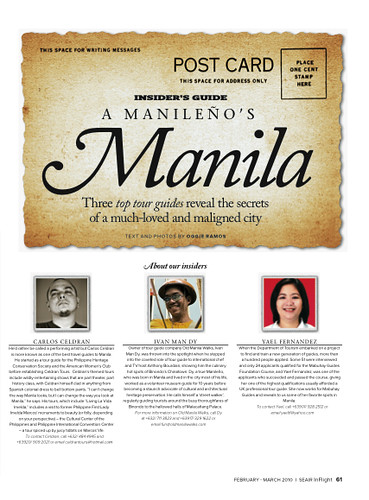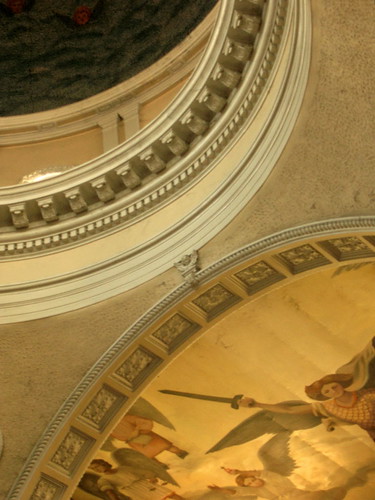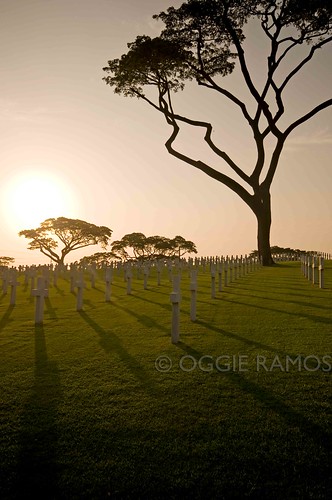 Metro Manila is a city of paradoxes. On the one hand, there are the 21st century gleaming skyscrapers along Ayala Avenue, the glitz of the High Street swanky shops in Bonifacio Global City, the private mansions and villas of Forbes Park, and the old world charm of the Spanish colonial walled city of Intramuros. And on the other, in the midst of the growing affluence, pockets of poverty in slums and unkempt areas. Truth is, like most developing areas, Manila is a “love it or hate it” city. It’s easy to hate the traffic jams, pollution, the manana habits, and be saddened by the desperateness of its poor quarters, but then again you meet some genuinely friendly, warm, and hospitable, and fun-loving people, and experience a city with a big heart.
Metro Manila is a city of paradoxes. On the one hand, there are the 21st century gleaming skyscrapers along Ayala Avenue, the glitz of the High Street swanky shops in Bonifacio Global City, the private mansions and villas of Forbes Park, and the old world charm of the Spanish colonial walled city of Intramuros. And on the other, in the midst of the growing affluence, pockets of poverty in slums and unkempt areas. Truth is, like most developing areas, Manila is a “love it or hate it” city. It’s easy to hate the traffic jams, pollution, the manana habits, and be saddened by the desperateness of its poor quarters, but then again you meet some genuinely friendly, warm, and hospitable, and fun-loving people, and experience a city with a big heart.Three top tour guides -- Carlos Celdran, Ivan Man Dy and Yael Fernandez -- help us see Manila in a new light. Here's a run-down of what's on top of their lists:
1 INTRAMUROS - The Walled City of Intramuros, a city within a city with surrounding walls up to 22-foot high, was built in 1571 to protect the seat of the Spanish colonial government and its people from hostile native revolts and pirates. These days Intramuros is a tourist attraction and a reminder of the country’s colonial past. Dy suggests climbing up the Baluarte de San Andres for a gorgeous view of Old Manila. Celdran calls Intramuros “the birthplace of Manila,” and here, one can find Fort Santiago, the baroque San Agustin Church, the Manila Cathedral, as well as the Casa Manila and Bahay Tsinoy museums within the walled city’s 64-hectare grounds. The cobble stone streets and old stone houses share space with shops, schools and restaurants. Both Celdran and Dy offer walking tours of Intramuros.
2 CHINATOWN - While virtually every country in the world has its own version of Chinatown, the one in Manila holds the record of being the oldest. Established in 1594, Manila Chinatown occupies about a square kilometer of land bustling with commerce, culture and religious fervor. Dy calls Chinatown “Manila’s culinary wonderland; its food, culture, history and streetlife in one fascinating district.” His favorite stops include the old mami houses and panciterias serving various types of noodles and steaming congee. Celdran finds color in Chinatown, a place for wholesale shopping and a voodoo market in one. He suggests stopping by the popular 168 Mall for anything and everything at rock-bottom prices. Fernandez points out that the first Filipino saint, Lorenzo Ruiz, served as an altar boy in Binondo Church.
 Various Chinatown tours are now available. Join Celdran’s Downtown Express Halo Halo Tour, a carriage ride through Binondo, Escolta and Quiapo. The tour includes stops at Plaza Ruiz, Binondo Church, Carvajal Street Market, Santo Cristo de Longos, Ongpin, Escolta, Escolta Street Musuem, Carriedo Fountain, Santa Cruz Church, Evangelista Herbalist Market and Quinta Market. Dy’s The Big Binondo Food Wok tour takes tourists through 400 years of history and four hours of indulgence, with stops at Plaza Calderon dela Barca, Basilica de San Lorenzo Ruiz, Santo Cristo de Longos Shrine, Ongpin Street and Carvajal Alley Market.
Various Chinatown tours are now available. Join Celdran’s Downtown Express Halo Halo Tour, a carriage ride through Binondo, Escolta and Quiapo. The tour includes stops at Plaza Ruiz, Binondo Church, Carvajal Street Market, Santo Cristo de Longos, Ongpin, Escolta, Escolta Street Musuem, Carriedo Fountain, Santa Cruz Church, Evangelista Herbalist Market and Quinta Market. Dy’s The Big Binondo Food Wok tour takes tourists through 400 years of history and four hours of indulgence, with stops at Plaza Calderon dela Barca, Basilica de San Lorenzo Ruiz, Santo Cristo de Longos Shrine, Ongpin Street and Carvajal Alley Market. 3 NATIONAL MUSEUM - Celdran suggests visiting on a Sunday when admission is free. The museum, a must for every self-respecting Filipino, is a repository of the Philippines’ natural and cultural heritage, housed in three buildings in Manila, and comprised of the National Art Gallery, Museum of the Filipino People, and Planetarium. The art gallery is the permanent home of Filipino artist Juan Luna’s immortal masterpiece, Spolarium, painted in 1884, as well as the priceless works of Filipino masters such as Fernando Amorsolo, Vicente Mananansala, Jose Joya, Cesar Legaspi, H.R. Ocampo, visual artist BenCab and sculptors Napoleon Abueva and Guillermo Tolentino. Its significant collections span from archeological finds from as early as 16,000 B.C. to modern-day animals in its zoological collection. At the adjacent building, one can find the Museum of the Filipino People, four floors of changing exhibits including artifacts, treasures and armaments recovered from the Spanish battleship, San Diego. The museum shop sells Filipino handicraft and trinkets ideal for souvenirs. • National Art Gallery Museum of the Filipino People exhibit days are from Wednesday to Sunday, 10am to 4:30pm, Tel: +632/ 527 0278 • Planetarium exhibit days are from Tuesday to Saturday, 9am to 4:30pm, Tel: +632/ 527 7889 • Museum is located on Padre Burgos Avenue • Email [email protected]
4 AMERICAN MEMORIAL CEMETERY - Located on 152 acres of land on a plateau in Taguig City, the American Memorial, with its 17,206 graves, is the largest cemetery in the Pacific for the US military dead of World War II. It also contains the war dead from the Philippines and allied forces. The memorial is a great vantage point for viewing the city. Dy’s favorite spots are the benches around the memorial, offering a view of the cemetery’s well-manicured lawns and plots that form a symmetrical, circular pattern hemmed with tropical trees and shrubbery. Fernandez suggests visitors take a good look at the chapel and the 25 mosaics that dramatize the achievements of the US forces in the Pacific, China, India, and Burma during WWII. The cemetery is open daily to the public from 9am to 5pm except Christmas and New Year’s Day. A staff member is on duty to answer questions and escort relatives to grave and memorial sites.
5 LUNETA - The 58-hectare Rizal Park, named after Philippine national hero Jose Rizal, who died defending his patriotic belief and immortalized in a monument erected in the park, is a favorite weekend place for Filipinos wanting to spend time away from the malls. The park, or Luneta, stretches from Taft Avenue to the seawall of Manila Bay, and has gardens, plazas, a stadium observatory, open-air concert hall, light and sound theater, fountains, playgrounds and food outlets. History buffs will appreciate the Lights and Sounds of Rizal, an audio-visual and three-dimensional diorama of Rizal’s execution, with life-sized sculptures by Eduardo Castrillo. There’s also an open air theater presentation, The Martyrdom of Dr. Jose Rizal, featuring a 30-minute dramatization of Rizal’s final hours. The Lights and Sounds of Rizal is shown Wednesday to Sunday, 7pm-7:30pm (Tagalog version) and 8pm-8:30pm (English version) while guided tours are from Wednesday to Sunday, 9am-5pm. Both come with a fee.
UP NEXT: Get to know your Manila guides and their favorite Manila haunts. Watch out for A Manileño's Manila, Part 2 featuring Carlos Celdran
Attribution: Article culled from Seair InFlight Magazine, February-March 2010 issue • All text and photos by Oggie Ramos except Rizal Park photo by Ferdz Decena. • Layout and art direction by Jocas A. See • For subscriptions, call (+632) 8402803





